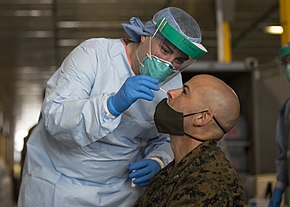
Back المسحة البلعومية الأنفية Arabic Frotis nasofaringi Catalan Nasopharyngeal swab English Cultivo nasofaríngeo Spanish Écouvillonnage nasopharyngé French Usap nasofaring ID Tampone rinofaringeo Italian നേസോഫാരിൻജിയൽ സ്വാബ് Malayalam Zaragatoa nasofaríngea Portuguese Nasopharyngeal swab Singhalese
| Swab nasofarinks Nasopharyngeal swab | |
|---|---|
 Ujian swab nasofarinks | |
| Tujuan | Diagnosis jangkitan virus tertentu |
| MedlinePlus | 003747 |
Swab nasofarinks merupakan kaedah untuk mengumpul ujian klinikal sampel daripada hingus dari belakang hidung dan tekak.[1][2] Sampel yang diambil, kemudiannya dianalisis untuk kehadiran organisma atau gejala/tanda perubatan lain untuk penyakit. Kaedah diagnostik ini biasanya digunakan dalam kes batuk kokol, difteria, influenza dan pelbagai jenis penyakit yang disebabkan oleh keluarga virus koronavirus, termasuk SARS, MERS dan COVID-19.[3][4][5][6][7][8]
- ^ "Nasopharyngeal culture". MedlinePlus. 23 March 2020. Dicapai pada 25 March 2020.
- ^ Pavord, T.; Pavord, M. (2004). The complete equine veterinary manual: A comprehensive and instant guide to equine health (ed. 2nd). David & Charles. m/s. 206. ISBN 9780715318836.
- ^ Junkins, A. (2010). "20. Identification of Pathogenic Bacteria". Dalam Mukherjee, K.I.; Ghosh, S. (penyunting). Medical Laboratory Technology. 2 (ed. 2nd). Tata McGraw-Hill. m/s. 515. ISBN 9781259000768.
- ^ "Specimen Collection". Pertussis (Whooping Cough). Centers for Disease Control and Prevention. 18 November 2019. Dicapai pada 25 March 2020.
- ^ Irving, S.A.; Vandermause, M.F.; Shay, D.K.; Belongia, E.A. (2012). "Comparison of nasal and nasopharyngeal swabs for influenza detection in adults". Clinical Medicine & Research. 10 (4): 215–8. doi:10.3121/cmr.2012.1084. PMC 3494547. PMID 22723469.
- ^ "Influenza Specimen Collection" (PDF). Centers for Disease Control and Prevention. n.d. Dicapai pada 25 March 2020.
A nasopharyngeal (NP) swab is the optimal upper respiratory tract specimen collection method for influenza testing.
- ^ McPherson, R.A.; Pincus, M.R. (2017). Henry's Clinical Diagnosis and Management by Laboratory Methods (ed. First South Asia). Elsevier. m/s. 1083. ISBN 9788131231272.
- ^ World Health Organization (19 March 2020). "Laboratory testing for coronavirus disease (COVID-19) in suspected human cases: Interim guidance, 19 March 2020". WHO/COVID-19/laboratory/2020.5. World Health Organization. Dicapai pada 25 March 2020.
© MMXXIII Rich X Search. We shall prevail. All rights reserved. Rich X Search